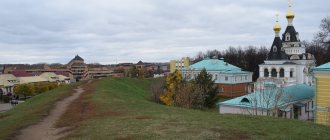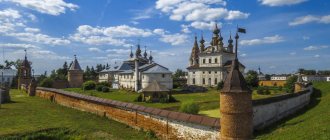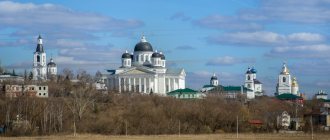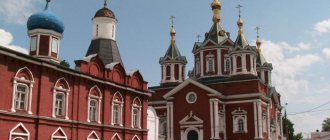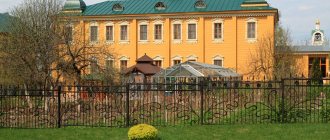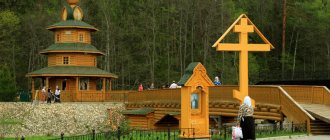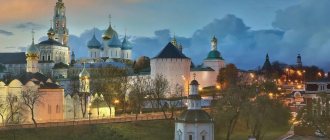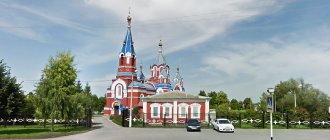LiveInternetLiveInternet
Monday, January 16, 2021 10:59 + to quote book Nadezhdaaa
all posts by the author Let's continue our walk around Yelets. But now our road leads to the temple. It’s an amazing city - no matter what road you take, you’ll still come out to the temple!
The travel agency calls Yelets a city of 33 churches! As of today, I read that there are only twelve operating temples left. Is it so? I don’t know... Do you and I need to do this arithmetic? It’s better to go and look at the temples that we met on the way that day. Let's start with the main attraction of the city - the Ascension Cathedral in the Russian-Byzantine style. It is one of those in Russia that amazes in size, like the Cathedral of Christ the Savior in Moscow and St. Isaac's Cathedral in St. Petersburg.
It was built in 1845, it was designed and supervised by Konstantin Andreevich Ton, by the way, the author of the Grand Kremlin Palace, the Armory and the Cathedral of Christ the Savior! Since then, the building has been reconstructed many times.
Emperor Nicholas I ordered that the architect Konstantin Ton be given royal favor for the beauty of the Ascension Cathedral project.
In the 1930s, the cathedral suffered the same sad fate as many other churches in our country. The icons were destroyed, burned right in the temple, all valuables were taken away, and the building was turned into a warehouse. The Grand Ducal Church will not be inferior in beauty and grandeur. It was erected in 1911 in honor of the 300th anniversary of the reign of the Romanov dynasty. The author of the project is the architect E.E. Wilfahrt.
The church was dedicated to the holy princes Mikhail of Tver and Alexander Nevsky and was built as a temple for the society of banner bearers.
The name of the merchant of the first guild A.N. Zausailov, who supplied shag to the Court, which assumed all the costs of building this temple, will forever remain in the history of the city.
Church of Michael the Archangel in the Russian-Byzantine style with a refectory and bell tower (1788).
Closed in the 1930s and used as a warehouse. In the 1990s it was returned to believers. Now they are trying to restore it.
The Church of the Intercession of the Blessed Virgin Mary was built according to the design of the architect A. A. Ton at the expense of the parishioners.
Closed in the early 1930s, used as a granary, then as a warehouse, and the bell tower was demolished in the 1960s. In 1997 it was returned to believers.
Church of the Transfiguration of the Lord. By the middle of the 18th century. The wooden Transfiguration Church became completely dilapidated and then its parishioners - Yelets merchants Stefan Vasilyevich Shaposhnikov, Stefan Yakovlevich Shaposhnikov and Kosma Leontyevich Sergeev in 1761 began to ask Voronezh Bishop Kirill for permission to build a new temple. This church was built and consecrated only in 1771.
In the 30s, workers demanded to close the church and equip a film installation there, because they were in great need of cultural and educational institutions. As a result, it became just another grain warehouse.
The Church of the Assumption of the Blessed Virgin Mary is a two-story stone church in the style of classicism (1815-1829), with an octagonal dome and four small domes.
The refectory connects the temple with a high bell tower, built in 1833-1847. Closed in the 1930s, used as a warehouse. Well, in general, nothing new.
In the 1990s it was returned to believers and renovated.
I wish I had been in this city before the revolution! When all the churches were operational and stood to the joy of the Orthodox in all their beauty, in all their greatness and dignity. Can you imagine what the chime was like at Easter?
| Categories: | architecture/Temples, cathedrals, sacred architecture Across Russia/Across cities and villages travel |
Cited 10 times Liked by: 23 users
Like share
0
Like
- 23
I liked the post - Quoted
- 0
Saved
- Add to quote book
- 0
Save to links
Liked23
0
Temples and monasteries in Yelets
The history of the Yeletsky Trinity Monastery can be divided into two periods. During the first of them - from 1592 to 1775 - the ancient monastery was located on a high cape on the right bank of the river. Elchik, at its confluence with the river. Pine. After its abolition during the reign of Empress Catherine II, the monastery was rebuilt in 1836 in a new location - on the western outskirts of Yelets, behind the outpost, on the Oryol road - where it existed until its closure, which followed shortly after the revolution.in 1919, the Trinity Monastery was closed, and part of its premises were transferred to the proletarian commune. The question of creating a commune was raised as early as January 15, 1919, but it was created no later than March, after the “Bulletin of the Poor” in February 1919 suggested that “nationalized monasteries with model farms should be transferred to Soviet farms.” In connection with the creation of the first proletarian commune on the basis of the monastery, the inhabitants of the Trinity Monastery were pushed out, and then conflicts began, provoked by the “builders of a bright future.”
One of the last solemn church services on the occasion of the patronal feast took place in the monastery on the day of the Holy Trinity on June 13, 1919. At the same time, at their meeting, the communards of the 1st branch of the Yeletsk proletarian agricultural commune unanimously “decided to petition the department. ext. management and the Council of Deputies on the temporary closure" of the monastery church.
By the summer of 1922, the residents of Yeltsov lost the opportunity not only to bury their loved ones in the revered monastery graveyard, but also simply to visit holy graves - according to the Rostovtsevs, “everything there is distorted.”
In subsequent years, there was a gradual destruction of the monastery churches and other buildings, as eloquently evidenced by the decision of the Yelets authorities to satisfy the petition of the commune to build a dairy farm and barnyard from the remaining bricks from the destroyed church of the former monastery.
After the war, the surviving buildings of the former Trinity Monastery belonged to the commune of the Rodina branch of the Yeletsky state farm, and on June 27, 1963, the building of the Tikhvin Church, which was in disrepair, was transferred from the balance of the Yeletsky state farm to the balance of the Yeletsky city council.
On October 18, 1963, by decision of the Lipetsk Regional Executive Committee No. 766-686, all monastery buildings with a total book value of 25,758 rubles. were transferred to the Yeletsstroy trust: residential building (calf barn) - 2311 rubles; warehouse (former church) - 6878 rubles; vegetable storage - 492 rubles; warehouse (former bakery) - 1288 rubles; basement under the bakery - 63 rubles; basement under the forge - 90 rubles; basement under the church - 388 rubles; water tower (bell tower - author's note) - 3045 rubles; fence of the former monastery - 8250 rubles; garage in a fence - 1975 rubles; forge - 978 rub.
Soon after this, the two main churches of the Trinity Monastery were finally destroyed - in 1965 the Trinity Cathedral was blown up, and in 1969 the Tikhvin Church was de-roofed and blown up.
In recent years, the territory of the monastery was occupied by motor depot No. 4, and apartments were built in the fraternal building and the Panteleimon Church attached to it.
Znamensky TEMPLE IN VESHALOVKA
Lipetsk region, Veshalovka
The warm stone church of the Icon of the Mother of God in the “pseudo-Gothic” style was founded in 1768 by the owner of the Guards estate, captain Yakov Afanasyevich Tatishchev (1725-1806). The church was built and consecrated in 1794. According to the church, the village was called Znamensky.
The author of the project was the then young architect Vasily Ivanovich Bazhenov (1737-1799), although a number of researchers question the authorship. The church is made of red brick and richly decorated with white stone elements. Initially, the bell tower stood separately, but then it was connected to the main building.
During the years of Soviet power, since 1932, the temple was not operational. Repair work began in 1987, the temple reopened only in 2003. While restoring the architectural monument, specialists also took care of the surrounding area - they made a new fence, paths and updated the landscaping.
When visiting the Znamensky Church, tourists are often interested in the fate of the Tatishchev estate next door. Unfortunately, all that remains of it is a beautiful turret and the ruins of a chapel with a family tomb.
SOURCE OF THE TIKHVIN ICON OF THE MOTHER OF GOD
Lipetsk region, Roshchinsky
The Ranenburg Peter and Paul Monastery, or Peter and Paul Hermitage, is famous for its wonderful shrine, which was discovered in our century - this is the healing spring of the Tikhvin Icon of the Mother of God. A holy spring with a bathhouse and a chapel is located under the walls of the monastery. Many pilgrims and those suffering from mental and physical ailments flock here.
The holy spring in honor of the Tikhvin Icon of the Mother of God plays an important role in the life of the monastery courtyard and all those who resort to it. The story of his miraculous appearance is unusual. This happened on the day of the celebration of the Tikhvin Icon of the Mother of God, July 9, 2007. On this holiday, during work to connect two ponds (Mother Neonilla, the abbess of the monastery, wanted to ennoble and adapt them for breeding fish, swans, lotuses) , an excavator removed a layer of earth from which 3 fountains of clean water began to noisily flow, it was the Lord who showed us His miracle. Bishop Tikhon of Yeisk came to the courtyard and, after talking with the workers and examining the place, he offered prayers to the Lord, and blessed to erect the Holy Cross in this place and erect a font for the joy of all suffering Orthodox Christians, travelers, pilgrims and all parishioners.
Lipetsk tourist server https://www.liptur.ru/
